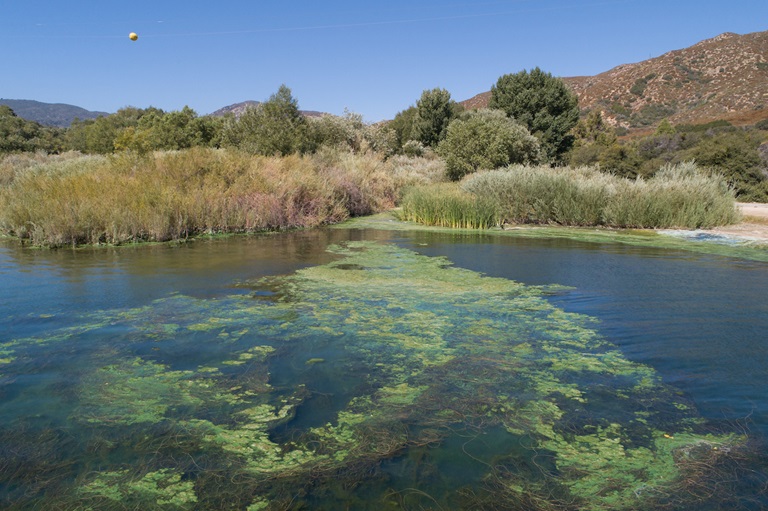How to Protect People and Pets from Harmful Algal Blooms
A drone provides an aerial view algae at Silverwood Lake, a reservoir in San Bernardino County, California. Photo taken September 19, 2019.
California’s waterways offer plenty of recreation opportunities this summer, but it’s important to also remember that with warm weather comes the potential for toxic algal blooms. When out on the water, be aware of the warning signs and make sure to always keep people and pets away from algae.
Blue-green algae (cyanobacteria), which naturally occur in bodies of water, can grow rapidly into an algal bloom due to factors such as warm water temperature, calm conditions, and certain nutrients in the water.
While some algae are harmless, certain types can produce toxins that can make people and animals sick. There is no way to tell if an algal bloom is toxic just by looking at it, so it’s best for swimmers and boaters to keep away from algal blooms.
The Department of Water Resources (DWR) regularly tests State Water Project (SWP) reservoir recreation areas for algal toxins. When tests are positive, signs are posted on site at the reservoir and online. Once toxic algae are found, testing continues weekly and algae advisories are not reduced until lab results show the water has been below the current advisory level for two weeks.
What are signs of Harmful Algal Blooms (HABs)?
• Small blue-green, green, white, or brown particles in the water
• Streaks in the water that look like spilled paint
• Mats, scum, or foam at the surface or along the shoreline
• Odors described as gasoline, septic, or fishy
What are the dangers?
Some algal blooms can produce toxins that are harmful to people and pets. Dogs and small children are most likely to be affected by HABs due to their smaller body size and probability to play in the water for longer periods.
Exposure can cause eye, nose, mouth or throat irritation, headache, allergic skin rash, mouth ulcers, vomiting, diarrhea, and cold- and flu-like symptoms. For dogs, symptoms can include vomiting, diarrhea, weakness, difficulty breathing, seizures, or even death.
How can I be exposed to algal toxins?
Exposure to algal toxins can happen during swimming or other water contact and when individuals accidentally swallow lake water. During waterskiing and jet skiing, the toxins can become airborne and inhaled.
People can also be exposed to toxins by eating shellfish and fish from affected waterbodies.
Dogs or other animals can become ill if they eat scum or mats in the water or on the shore, drink the water, or lick their fur after going into the water.
How can you protect yourself from HABs?
• Follow posted advisories
• Stay away from algae and scum in the water and on shore
• Watch children and pets closely
• Do not let pets and other animals go into the water, drink the water, or eat scum and algal accumulations on the shore
• Do not drink the water or use it for cooking
• Wash yourself, your family, and your pets with clean water after water play
• If you catch fish, throw away guts and clean fillets with tap water or bottled water before cooking
• Avoid eating shellfish from affected areas
More information available at:
DWR’s Algal Blooms website.
